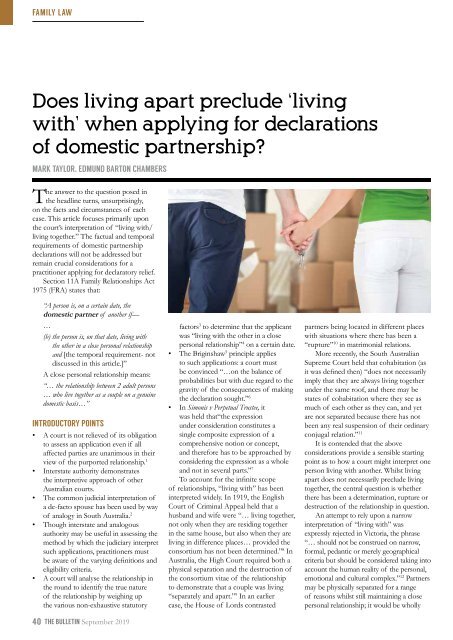LSB September 2019_Web
You also want an ePaper? Increase the reach of your titles
YUMPU automatically turns print PDFs into web optimized ePapers that Google loves.
FAMILY LAW<br />
Does living apart preclude ‘living<br />
with’ when applying for declarations<br />
of domestic partnership?<br />
MARK TAYLOR, EDMUND BARTON CHAMBERS<br />
The answer to the question posed in<br />
the headline turns, unsurprisingly,<br />
on the facts and circumstances of each<br />
case. This article focuses primarily upon<br />
the court’s interpretation of “living with/<br />
living together.” The factual and temporal<br />
requirements of domestic partnership<br />
declarations will not be addressed but<br />
remain crucial considerations for a<br />
practitioner applying for declaratory relief.<br />
Section 11A Family Relationships Act<br />
1975 (FRA) states that:<br />
“A person is, on a certain date, the<br />
domestic partner of another if—<br />
…<br />
(b) the person is, on that date, living with<br />
the other in a close personal relationship<br />
and [the temporal requirement- not<br />
discussed in this article.]”<br />
A close personal relationship means:<br />
“… the relationship between 2 adult persons<br />
… who live together as a couple on a genuine<br />
domestic basis…”<br />
INTRODUCTORY POINTS<br />
• A court is not relieved of its obligation<br />
to assess an application even if all<br />
affected parties are unanimous in their<br />
view of the purported relationship. 1<br />
• Interstate authority demonstrates<br />
the interpretive approach of other<br />
Australian courts.<br />
• The common judicial interpretation of<br />
a de-facto spouse has been used by way<br />
of analogy in South Australia. 2<br />
• Though interstate and analogous<br />
authority may be useful in assessing the<br />
method by which the judiciary interpret<br />
such applications, practitioners must<br />
be aware of the varying definitions and<br />
eligibility criteria.<br />
• A court will analyse the relationship in<br />
the round to identify the true nature<br />
of the relationship by weighing up<br />
the various non-exhaustive statutory<br />
40 THE BULLETIN <strong>September</strong> <strong>2019</strong><br />
factors 3 to determine that the applicant<br />
was “living with the other in a close<br />
personal relationship” 4 on a certain date.<br />
• The Briginshaw 5 principle applies<br />
to such applications: a court must<br />
be convinced “…on the balance of<br />
probabilities but with due regard to the<br />
gravity of the consequences of making<br />
the declaration sought.” 6<br />
• In Simonis v Perpetual Trustee, it<br />
was held that“the expression<br />
under consideration constitutes a<br />
single composite expression of a<br />
comprehensive notion or concept,<br />
and therefore has to be approached by<br />
considering the expression as a whole<br />
and not in several parts.” 7<br />
To account for the infinite scope<br />
of relationships, “living with” has been<br />
interpreted widely. In 1919, the English<br />
Court of Criminal Appeal held that a<br />
husband and wife were “… living together,<br />
not only when they are residing together<br />
in the same house, but also when they are<br />
living in difference places… provided the<br />
consortium has not been determined.” 8 In<br />
Australia, the High Court required both a<br />
physical separation and the destruction of<br />
the consortium vitae of the relationship<br />
to demonstrate that a couple was living<br />
“separately and apart.” 9 In an earlier<br />
case, the House of Lords contrasted<br />
partners being located in different places<br />
with situations where there has been a<br />
“rupture” 10 in matrimonial relations.<br />
More recently, the South Australian<br />
Supreme Court held that cohabitation (as<br />
it was defined then) “does not necessarily<br />
imply that they are always living together<br />
under the same roof, and there may be<br />
states of cohabitation where they see as<br />
much of each other as they can, and yet<br />
are not separated because there has not<br />
been any real suspension of their ordinary<br />
conjugal relation.” 11<br />
It is contended that the above<br />
considerations provide a sensible starting<br />
point as to how a court might interpret one<br />
person living with another. Whilst living<br />
apart does not necessarily preclude living<br />
together, the central question is whether<br />
there has been a determination, rupture or<br />
destruction of the relationship in question.<br />
An attempt to rely upon a narrow<br />
interpretation of “living with” was<br />
expressly rejected in Victoria, the phrase<br />
“… should not be construed on narrow,<br />
formal, pedantic or merely geographical<br />
criteria but should be considered taking into<br />
account the human reality of the personal,<br />
emotional and cultural complex.” 12 Partners<br />
may be physically separated for a range<br />
of reasons whilst still maintaining a close<br />
personal relationship; it would be wholly


















